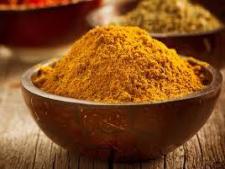-

curry powder
| Food | Percentage of DRI per 100 grams | |
|---|---|---|
| iron | 10 | |
| vitamin K | 8 | |
| vitamin E | 7 | |
| vitamin B6 | 4 | |
| calcium | 3 | |
| folate | 2 | |
Curry powder is one of the most popular spice mixes in existance, added to soups curries, stir-fries and sauces not just in Asian and Indian cuisine, but all over the world. The word curry means sauce, and in India the term refers to any vegetable or meat mixed with a savory sauce.
Curry powder gets its unique flavor by combining a whole host of sweet and savory spices. There is no standard curry powder recipe, the ingredients vary depending on availability and taste. Most curry powders include turmeric, coriander, cumin, chili and fenugreek. Additional ingredients may include asafoetida, cinnamon, cardamom, cloves, ginger, garlic, fennel seeds, mustard seeds and black pepper. The level of heat can vary significantly depending on how and what kind of chili is used.
VOLUME
Moderate/loud
HOW TO USE
It is recommended to add curry powder at the beginning of the cooking process. Most of the spices in curry powder are oil soluble, so frying them brings out the flavor. Ground spices are more delicate than whole, so be gentle with the heat and timing to avoid burning. Using curry powder raw is also an option, however the taste may be slightly bitter, the texture somewhat grainy and the final result not as flavorful. Choose a high quality and finely ground powder and use it as fresh as possible to enhance the result.
Indian families often make their own spice blends (masaalas) fresh daily, and rarely buy ground curry powder ready made. Making your own curry powder is a great way to get maximum flavor and freshness. Add 2 tablespoons cumin seeds, 2 tablespoons coriander seeds, 1/2 tablespoon black peppercorns, 1 teaspoon fenugreek seeds and 1 tablespoon black mustard seeds to a spice grinder and grind into a fine powder. Add 2 tablespoons turmeric powder and ground cayenne pepper to taste and stir until well combined.
FLAVOR PAIRINGS
Avocado, almonds, apples, aubergine, beans, bell peppers, black pepper, cabbage, cashews, carrots, cauliflower, chickpeas, chili, chutney, cilantro, cinnamon, citrus, cloves, coconut cream, coconut sugar, coriander, cumin, fennel seeds, fenugreek, galangal, garlic, ginger, grains, Kaffir lime, lemon, lemongrass, lentils, lime, mustard seeds, noodles, okra, onions, peas, peanuts, pineapple, potatoes, rice, scallions, sweet potatoes, tamari, tamarind, tempeh, tofu, tomatoes, turmeric, vegan mayonnaise, vegan yogurt, zucchini.
SELECTING
Mild curry powder is brightly yellow, whereas spicy curry powders are often more red due to a higher ratio of chili. Maharaja curry powder is mild whereas Vindaloo and Madras curry powders are significantly more spicy.
STORING
Store in an air-tight container in a cool, dry and dark place for up to 6 months. Keep in mind that the flavor will fade after a few months although the powder may still be fine to use. For longer shelf life store in the refrigerator.
SUBSTITUTIONS
To substitute curry powder mix equal parts of cumin powder, coriander powder and turmeric powder. Add chili pepper to taste.
HEALTH BENEFITS
With its combination of many medicinal spices, curry powder provides an array of health benefits.
Turmeric is an adaptogen that enhances the immune system and protects against Alzheimer´s, heart disease, osteoporosis and even cancer. Rates of Alzheimers are significantly lower in India, and the hypothesis among many researchers is that curry spices (in particular the turmeric) is to thank for that. Other medicinal properties in curry powder come from the cumin seeds which are a great digestive aid, flushing out toxins and protects the liver and kidneys. The coriander seeds also help with digestion and stomach related ailments, reduces LDL cholesterol and supports cardiovascular health.
HISTORY
Most people think of curry powder as an authentic Indian spice blend, but was actually invented by the Brittish in the 18th century. Indian families would go to great length cooking with an array of flavorful and aromatic spices. Indian cuisine soon became popular in other parts of the world, and the curry spice blend was invented to replicate those Indian flavors with a more simple cooking and shopping process.
REFERENCES
- Mateljan, George. The World´s Healthiest Foods. Nov 2020 http://www.whfoods.com/index.php
- Ensminger AH, Esminger M. K. J. e. al. Food for Health: A Nutrition Encyclopedia. Clovis, California: Pegus Press; 1986. 1986. PMID:15210.
- Fortin, Francois, Editorial Director. The Visual Foods Encyclopedia. Macmillan, New York. 1996.
- Grieve M. A Modern Herbal. Dover Publications, New York. 1971.
- Martinez-Tome M, Jimenez AM, Ruggieri S, et al. Antioxidant properties of Mediterranean spices compared with common food additives. J Food Prot 2001 Sep;64(9):1412-9. 2001. PMID:12440.
- Wood, Rebecca. The Whole Foods Encyclopedia. New York, NY: Prentice-Hall Press; 1988. 1988. PMID:15220.
- http://nutritiondata.self.com/facts/spices-and-herbs/185/2
- https://www.organicfacts.net/health-benefits/herbs-and-spices/health-benefits-of-curry-powder.html